Flying stones of Lapland
I have been having an interesting email correspondence with Vyacheslav Mizin, a Russian in St. Petersburg who found my site and wrote to me about his interests and research into Arctic stone cultures. His research trips around the St. Petersburg region, Murmansk region and Karelia are the subject of a report he is preparing for the Russian Geographical Society in St. Petersburg and for a book he is writing. Vyacheslav sees many parallels between the northern European Saami and Canada’s Inuit and hopes to put together a website on this.
He has kindly allowed me to share some of his writing and photos here in the hope that these Russian Arctic megaliths will be of interest outside Russia. (By his request, I have edited the English, but only minimally and I hope correctly.)
“Flying stones of Lapland”: Northern megaliths of Russian Arctic Region.
In the Karelia and the Murmansk region of north-west Russia are many ancient places of power with sacred stones from pre-historic ages. The Saami (Lapps), who are the most ancient Finno-Ugric people of northern Europe, named these stones “seidas”. Their weight can be up to 20 tons, some lie singly, some are in complexes of hundreds of stones. One of the riddles concerning seidas is their similarity with dolmens of Western Europe, Canada and Korea. If these stones were not in the Arctic but instead in England, they would be named dolmens. Near seidas there are often other megalithic forms – stone circles, stone heaps, square “altars”.
In Russia the known seida complexes are on Mount Vottovaara, in the national park of Paanajarvi in the Kuzova Islands in the White Sea. On the mountain seidas were put on other rocks, on marked tracks and in water, and in some places are in lines and circles. Some are located among contorted dead trees and this place is a “place of power”, the centre of an ancient earthquake and with a bad reputation.
Lapland has legends that seidas could fly – that has given it the second name Laplandia – “country of a flying stone”. Another Saami legend is when the spirit departs from a stone, the stone shatters.
Photos by Vyacheslav Mizin:
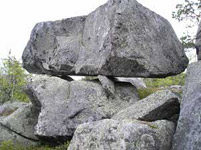 |
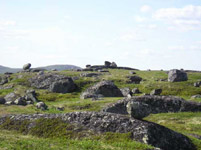 |
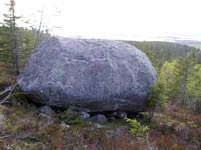 |
left: Note the delicate balance where the top stone actually keeps the lower ones from falling.
centre: A plateau of seidas in the hundreds in the Murmansk region
right: This Vottovaara seida weighs more than 10 tons.
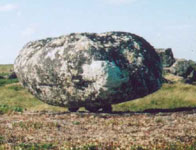 |
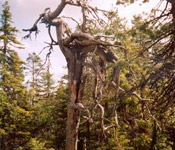 |
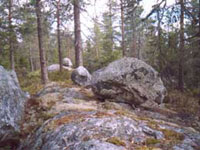 |
left: UFO-like seida in the Murmansk region
centre: Vottovaara trees, a Karelian place of power
right: Line of seidas in the Karelian woods on Vottovaara
I also have thought about these connections between the seidas of the Sami in NW Russia & Finland and the inuksuit in northern Canada. I was surprised that Korea was mentioned so he has provided this Korean site. The expression “places of power” seems to be common in discussions of the sacred rock art of the north!
Related to this is an earlier post I wrote on Karelia’s rock art, which has a page on seidas, including these Vottovaara photos (the top right photo here is Vyacheslav’s).
Visit Vyacheslav Mizin’s interesting site which has more photos, but unfortunately for now has little English and is very slow to download, and this site. Thank you for sharing!
Addendum Aug.28.04. Vyacheslav has just sent this newly translated page on Russian places of power.
Addendum Sept.17.04. Still more English pages on arctic megaliths.
(thanks Erika for helping me with the photo placement! )
August 25, 2004 in Finland, Estonia & Finno-Ugric, Rock Art & Archaeology by Marja-Leena
Also fascinating!
Oh, I like those crazy stones. Especially the huge ones balancing on a handful of small stones. To my amateur eye, it seems mysterious how they got where they are–glaciers? humans? Hard to tell.
Thank you both for the comments and visits! The theory is that these seidas were done by humans along the line of stones like at Stonehenge..amazing isn’t it?! How do they do it?